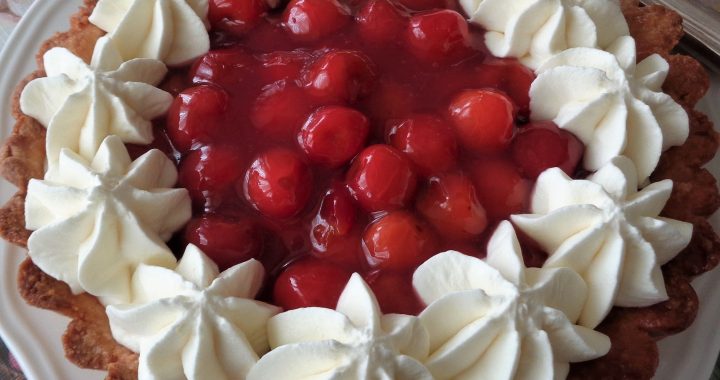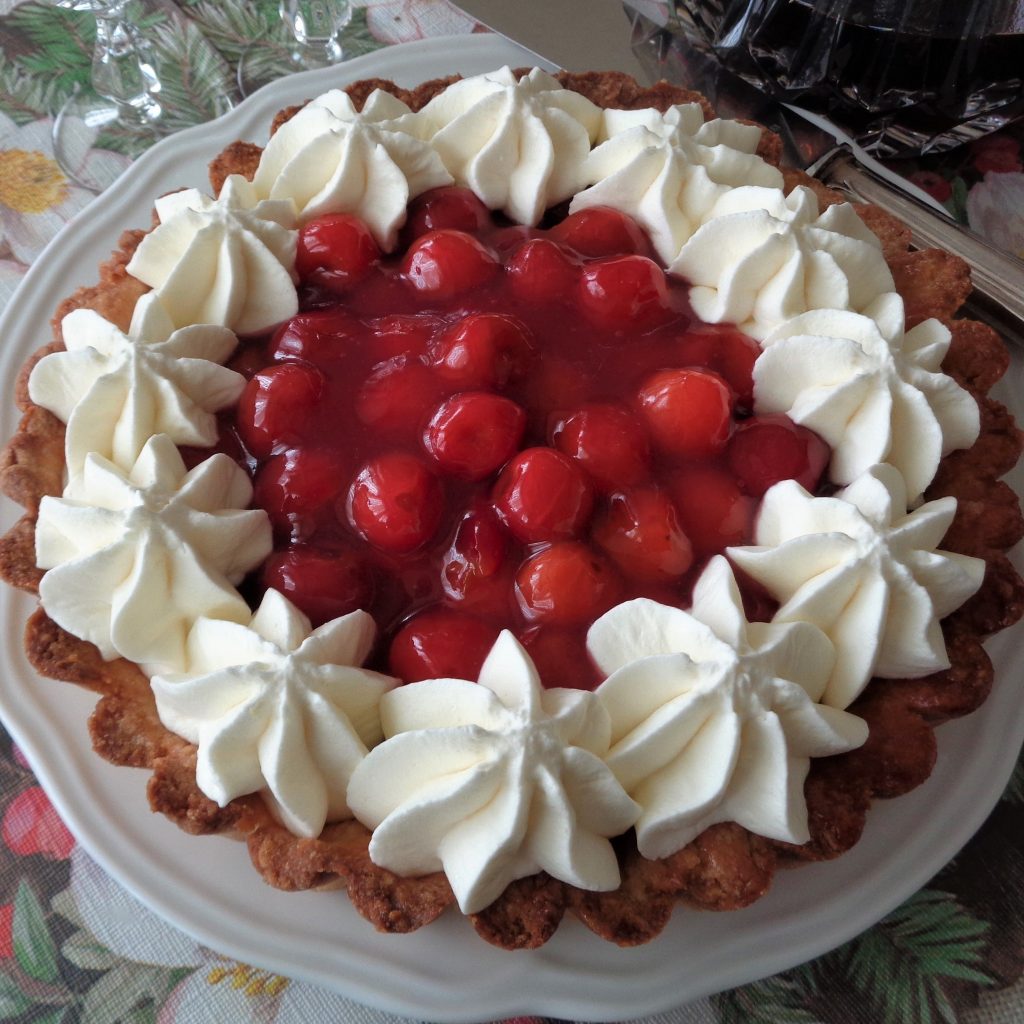I am back for round two. I still have no idea what button I pushed that deleted the entire post and left me with one lonely “t”. My hope is that in the end what gets created now will be a better post.
Sour cherries have a very limited season. They are generally ripe mid July in this part of the world. The local orchard will be open until July 31st this year, perfect for a Lughnasadh treat.
I was blessed with a bowlful from a friend’s tree earlier this week. It was the very first time my friend had had enough of a harvest to bake a pie with a few leftovers to share. I showed the cherries to my stepmother and they brought back memories of a nut cake her mother had made when she was young, with a sour cherry filling. Further discussion and “cake” became “pie”. ( It is not always easy trying to recreate from someone else’s memories of 80 years ago).
This is a recipe that usually is made in a springform pan for larger numbers of people. We are a household of two with 3 cups of cherries so I chose my 8 inch fluted pastry pan with removable bottom.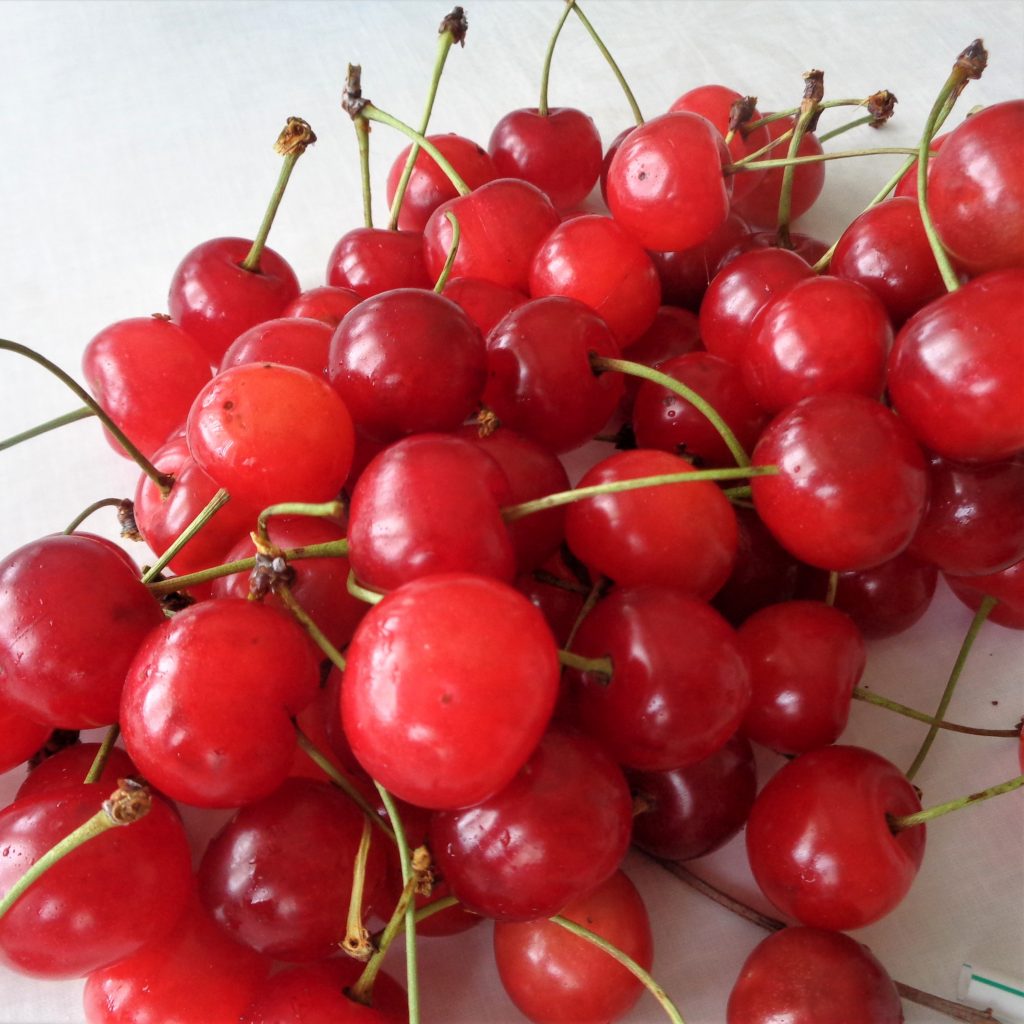
You will need:
1 baked pie shell
3 cups sour cherries, washed and pitted
1 cup of sugar, in two equal sections
1/2 cup juice/water
3 Tbsp. cornstarch
2 – 3 Tbsp. ground nuts
sweetened whipped cream
With so many fruits being ripe for the picking, there are multiple reasons to be grateful. Close your eyes and take a deep breath. Let your shoulders drop and slowly, deeply take another good breath. We are all carrying extra stress through the pandemic and consciously letting go is a good practice, even without a kitchen project. Take a moment and bring your focus into the present moment. Open your heart and begin.
Mürbeteig is a German pastry that is also known as 1,2,3 pastry as it is ( in general) 1 part sugar, 2 parts butter and 3 parts flour to which 1 egg is added. When Googled, the information says it is a short crust pastry and that is where the discussion got a little confusing. If you have a standard pastry recipe that you are happy with and comfortable making then please use that. If you are up for an adventure, this is Mürbeteig. It is used for Christmas cookies, fruit tarts, “cakes” and there is also a savoury option for quiche.
You will need:
1/2 cup sugar
1 cup butter
2 cups flour
1 cup ground hazelnuts ( as the cupboard was bare of hazelnuts, I used 1 cup almond flour)
1 egg
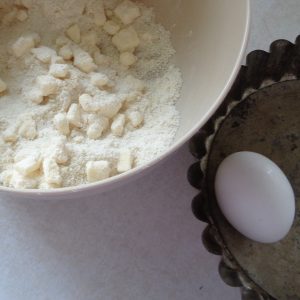 Mix together the flour and ground nuts. Some recipes call for a pinch of salt but that is because most German butter is unsalted. Using salted butter is an option and if going the unsalted route then an added sprinkle is good idea.
Mix together the flour and ground nuts. Some recipes call for a pinch of salt but that is because most German butter is unsalted. Using salted butter is an option and if going the unsalted route then an added sprinkle is good idea.
There is much discussion about whether the butter should be cold or room temperature. If you have been reading My Kitchen Wand recipes for a while you will know that I will choose the room temperature option.
If you feel more comfortable cutting in the harder butter, please do that. Whichever choice you make, work the mixture until the butter is in small pieces, still visible and well dispersed in the dry ingredients. The picture here is at the beginning of the process.
Too much mixing  and the flakiness will disappear. It is important that the small pieces of soft butter melt leaving layers in the finished pastry.
and the flakiness will disappear. It is important that the small pieces of soft butter melt leaving layers in the finished pastry.
Once the fat has been cut in and crumbled, add the egg.
Mix together and collect the dough into a ball.
It is possible to wrap and put the dough into the fridge at the point. It is also possible to roll out the dough, transfer it to the pie form and then put the finished pie shell in the fridge for an hour so the butter can firm up again.
Prick the unbaked shell before baking in a 375 degrees F. until golden brown. Set aside to cool.
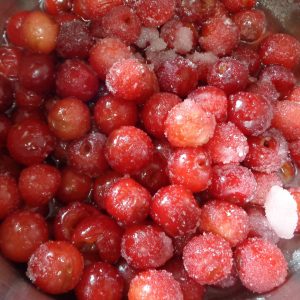 While the pie is baking move on to the cherries. In the picture above at the bottom right side you will see just the tip of a straw. This is a simple way to pit sour cherries which are usually too small for a cherry pitter and also for the bottle and chopstick method of pitting cherries.
While the pie is baking move on to the cherries. In the picture above at the bottom right side you will see just the tip of a straw. This is a simple way to pit sour cherries which are usually too small for a cherry pitter and also for the bottle and chopstick method of pitting cherries.
Wash the cherries and gently pull out the stem. If you are lucky the stone will come out attached to the stem. If that doesn’t happen then use the straw to gently push the stone through the cherry and out the opposite end. Check for and remove any blemishes.
In a pot add 1/2 cup sugar. Allow the sugar some time to pull out the juices of the fruit. I left them overnight but it is not necessary that it be that long. Separate the juice and add any extra water needed to measure 1/2 cup.
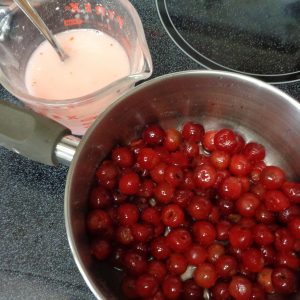 Combine the last 1/2 sugar with the cornstarch and juice. Stir until mixed and the cornstarch is well blended.
Combine the last 1/2 sugar with the cornstarch and juice. Stir until mixed and the cornstarch is well blended.
Return the liquid to the pan and bring to a simmer. The sauce will clarify as the liquids cook and thicken.
Take the mixture off the heat and allow to also cool.
Whip the cream with sugar to taste until stiff peaks form. I have a bottle of vanilla flavoured sugar that I use for whipping cream. One half to one teaspoon vanilla extract is another option.
When everything is cooled and ready to be put together, sprinkle the remaining ground nuts over the bottom of the pie shell. This will absorb moisture and keep your pie shell crisp longer.
Using a slotted spoon, spoon the cherries into the pie shell. I use a slotted spoon so the amount of sauce can be better controlled. When the cherries are fully transferred, decide how much of the left over sauce works for you and drizzle on top.
In my stepmother’s mind, the finished dessert was fully covered in whipping cream and eventually that happened here too but I thought a more interesting picture might happen with just a ring of cream around the outside.
Did I get it right? Not entirely but by the time my stepmother was through afternoon coffee and dinner, the pie was gone so I don’t think I was too far off.
Do you also have childhood memories of dishes from days gone by? It may be time to play a little.

